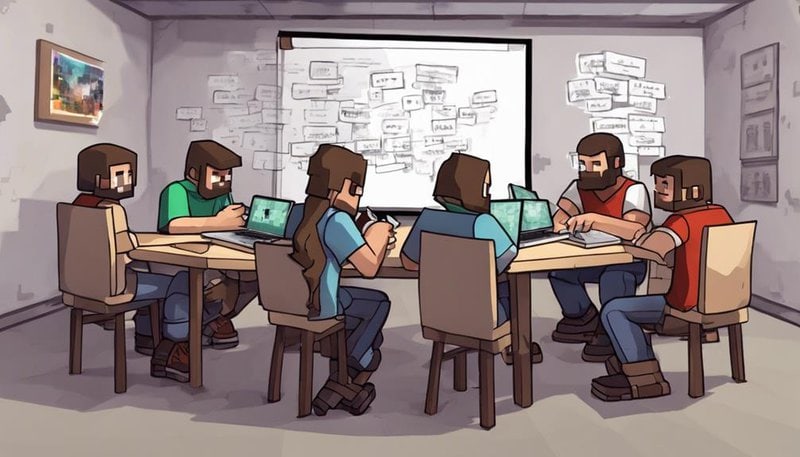How to Discuss and Set Minecraft Gameplay Rules

When discussing and setting Minecraft gameplay rules, it is important to involve all players in the process to ensure everyone's input is considered. Start by outlining the objectives of the game and what behaviors are acceptable or not. Clearly define rules regarding building, resource gathering, player vs. player interactions, and any other specific aspects of gameplay.
It is also crucial to establish consequences for breaking the rules to maintain a fair and enjoyable gaming environment for all participants. Regularly review and revisit the rules as needed to address any issues that may arise during gameplay. By setting clear and consistent rules, players can enjoy a more structured and engaging Minecraft experience.
Importance of Establishing Clear Rules
Establishing clear rules in Minecraft gameplay guarantees a fair and enjoyable experience for all players involved. Clear communication is key when setting these rules to make certain that everyone understands what's expected. Whether it's defining building boundaries, outlining PvP (Player vs. Player) guidelines, or establishing resource-sharing protocols, clarity is essential. Without clear rules, confusion can arise, leading to disputes and a less enjoyable gaming experience for all.
Rule enforcement is another critical aspect of maintaining a balanced gameplay environment. Players must understand that rules are in place for a reason and that enforcement is necessary to uphold fairness. Consistent enforcement helps prevent cheating, griefing, or other disruptive behaviors that can detract from the overall gaming experience. By enforcing rules fairly and promptly, you create a more enjoyable atmosphere where players can focus on creativity, collaboration, and friendly competition. Remember, clear communication and rule enforcement are the pillars of a thriving Minecraft community.
Understanding Player Preferences
When it comes to Minecraft gameplay, understanding player preferences is key. Analyzing what players enjoy can help tailor their gaming experiences to be more engaging and enjoyable.
Player Preferences Analysis
Understanding player preferences is essential for game developers to create engaging and immersive gameplay experiences. By analyzing player preferences, you can tailor the gameplay to suit the needs and desires of your audience. Below is a table that showcases different player preferences that can impact engagement and rule enforcement in Minecraft:
| Preference | Impact on Player Engagement | Impact on Rule Enforcement |
|---|---|---|
| Exploration | High | Low |
| Creativity | High | Low |
| Competition | Medium | Medium |
| Cooperation | High | High |
Tailoring Gameplay Experiences
To tailor gameplay experiences effectively, it's essential to analyze and understand player preferences thoroughly. Customizing experiences based on player feedback can greatly enhance enjoyment and engagement. To achieve this, consider the following:
- Listen Actively: Pay attention to what players enjoy and what they find frustrating.
- Tailor Restrictions: Adjust gameplay restrictions to balance challenge and fun.
- Encourage Collaboration: Involve players in decision-making processes to make them feel invested.
- Flexibility is Key: Be open to tweaking rules based on ongoing feedback and evolving player dynamics.
Setting Boundaries for Gameplay
Establish clear and specific boundaries within your Minecraft gameplay to enhance your overall experience and promote fair play among all participants. Communication strategies are essential for setting these boundaries effectively. Clearly communicate the rules to all players at the beginning of the game or when new participants join. Encourage player engagement by involving them in the rule-setting process, making them feel more invested in the gameplay.
Rule enforcement is vital for maintaining a fair and enjoyable gaming environment. Clearly outline consequences for breaking the rules and make sure that all players understand the repercussions of their actions. Consistent enforcement of the boundaries will lead to increased player satisfaction as it creates a level playing field for everyone involved.
Addressing Cheating and Exploits
Let's address the elephant in the room – cheating and exploits in Minecraft.
It's important to establish a clear definition of cheating in-game and recognize common exploits that players might use.
Define Cheating In-Game
Cheating in Minecraft refers to the act of using unauthorized methods or exploiting glitches to gain an unfair advantage within the game. When defining cheating, it's important to establish clear boundaries to guarantee fair gameplay.
Here are some key points to bear in mind:
- Definition: Clearly outline what actions are considered cheating in your gameplay rules.
- Consequences: Make sure to communicate the repercussions of cheating to deter players from engaging in such behavior.
- Fair Play: Encourage a culture of fair play and sportsmanship among all participants.
- Reporting Mechanism: Implement a system for players to report suspected cheaters to maintain a level playing field.
Identify Common Exploits
By understanding the common exploits utilized in Minecraft gameplay, you can effectively address cheating and maintain a fair gaming environment for all players. Exploits in Minecraft can range from using hacked clients to gain an unfair advantage, exploiting glitches to duplicate items, or manipulating server settings for personal gain.
Detecting these exploits can be challenging, but implementing prevention strategies such as regular server checks, utilizing anti-cheat plugins, and staying informed about new cheat methods can help in maintaining a balanced gameplay experience.
Being vigilant and proactive in identifying and addressing these exploits is vital to upholding the integrity of the game and ensuring that all players can enjoy Minecraft in a fair and enjoyable manner.
Enforce Fair Play Rules
To maintain a fair gaming environment in Minecraft, it's essential to enforce strict rules against cheating and exploits. Promoting sportsmanship and preventing unfair advantages are key to guaranteeing an enjoyable gaming experience for all players.
Here are some important points to contemplate:
- Clear Guidelines: Establish clear rules against cheating and exploiting game mechanics.
- Consistent Enforcement: Make sure that rules are consistently enforced to sustain fairness.
- Educate Players: Educate players about the importance of fair play and the impact of cheating on the gaming community.
- Encourage Reporting: Encourage players to report any suspicious behavior to uphold the integrity of the game.
Consensus Building Among Players
When aiming for consensus among players in Minecraft gameplay, it's essential to foster open communication and collaborative decision-making. Building trust within your group is vital for establishing a strong foundation for rule-setting. Encourage honesty and transparency to make certain that everyone feels heard and valued. By fostering teamwork, you can create a cooperative environment where players work together towards common goals.
To build trust, start by actively listening to each player's ideas and concerns. Acknowledge their perspectives and show respect for their opinions. Engage in discussions where everyone has the opportunity to voice their thoughts and contribute to the decision-making process. This inclusivity will help strengthen the bond between players and increase their investment in the rules that are established.
Fostering teamwork involves promoting a sense of unity and collaboration among players. Encourage cooperative gameplay and emphasize the importance of working together to overcome challenges. By cultivating a supportive and harmonious atmosphere, you can make certain that consensus-building efforts are effective and successful. Remember, when players feel connected and valued, they're more likely to actively participate in rule-setting and adhere to the agreed-upon guidelines.
Documenting and Communicating Rules
Moving from reaching a consensus among players, the next step in creating a cohesive Minecraft gameplay experience involves clearly documenting and effectively communicating the established rules. When it comes to documenting and communicating rules for your Minecraft gameplay, follow these key steps for a smooth gaming experience:
- Rule enforcement: Clearly outline the consequences for breaking rules, making certain all players understand the importance of following the established guidelines.
- Player communication: Use in-game signs or a shared document to display rules prominently, making it easy for all players to access and refer back to when needed.
- Consistency is key: Make sure that rules are consistently enforced to maintain fairness and prevent misunderstandings among players.
- Regular reminders: Periodically remind players of the rules through group chats or meetings to reinforce the importance of adhering to them for a harmonious gameplay environment.
Monitoring and Adjusting Rules as Needed
Consider keeping a vigilant eye on gameplay dynamics to guarantee rules remain effective and fair for all participants. Rule flexibility is key in maintaining a balanced and enjoyable Minecraft experience. Regularly review player feedback to assess if adjustments are needed. Player input can provide valuable insights into how rules are impacting the overall gameplay balance.
When monitoring gameplay, pay close attention to rule enforcement. Ensuring that rules are consistently applied helps maintain a level playing field for all participants. Address any instances where rules may be unclear or causing confusion among players promptly.
It's essential to strike a balance between allowing players the freedom to enjoy the game and enforcing necessary guidelines to promote fair play. By staying attuned to the evolving dynamics of gameplay and being open to making adjustments when needed, you can create an environment where rules enhance the overall Minecraft experience for everyone involved.
Frequently Asked Questions
How Can I Handle Disagreements Among Players Regarding Gameplay Rules?
When handling disagreements among players about gameplay rules, prioritize conflict resolution through open communication. Enforce rules consistently and encourage team cooperation. Address concerns promptly to maintain a fair and enjoyable gaming environment for all.
Is It Necessary to Have Consequences for Breaking the Established Rules?
When players break established rules in Minecraft, implementing consequences is crucial to enforce boundaries. It guarantees fair play and maintains order. Clear consequences help maintain a balanced and enjoyable gameplay experience for everyone.
What Should I Do if a Player Repeatedly Cheats or Exploits in the Game?
If a player repeatedly cheats or exploits in the game, address the issue promptly. Enforce fair gameplay by implementing cheating consequences. Communicate clearly that rule enforcement is essential for an enjoyable and respectful gaming experience for all players.
How Can I Ensure That All Players Are Aware of the Rules and Any Updates to Them?
To guarantee all players know the rules and updates, use group communication. Remind them regularly of the rules, hold players accountable for following them, and notify them promptly of any changes. This keeps everyone informed and playing fair.
What Should I Do if a Player Refuses to Abide by the Agreed-Upon Rules?
If a player refuses to follow the rules, address it promptly. Clearly state consequences like temporary bans or loss of privileges. Use direct, respectful communication to explain the importance of rules and uphold fairness for all players.








